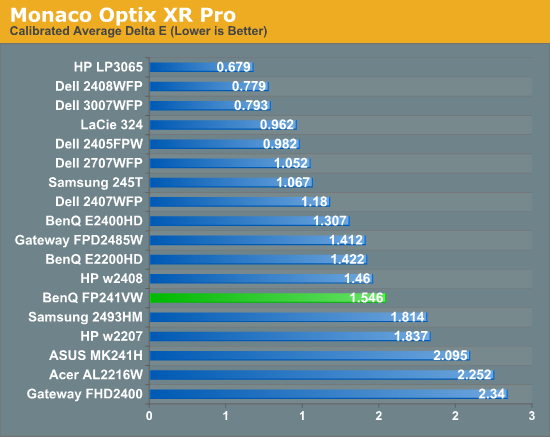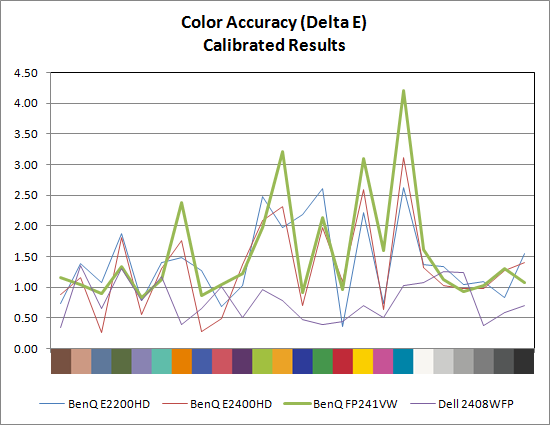Color Accuracy
Imaging professionals definitely like to have accurate colors, and the best way of assuring that your display shows the proper colors is to use a colorimeter and calibration software. However, not everyone has access to such tools and many users are unwilling to spend over $200, so we calibrate and test the various LCDs. We didn't perform a thorough evaluation of color accuracy on the FP241VW, so we will limit our Delta E comparison to calibrated performance where we target a white level of ~200 nits - anything more than that is too bright in our opinion. The FP241VW actually ended up at 270 nits, but that won't substantially affect any of the scores. Before we get to the results, here are the display settings we used on the BenQ LCDs. We let the LCDs stabilize for at least one hour before performing measurements. We will compare results with the Dell 2408WFP, which so far has achieved the best overall color accuracy of any LCD we have tested, as well as the previous two BenQ LCDs.
| LCD Brightness and Contrast Settings | ||
| Standard Calibrated (~200 nits) | Calibrated for Print (~100 nits) | |
| BenQ E2200HD | 65 Brightness, 50 Contrast "Normal" (95-95-95 RGB) |
20 Brightness, 50 Contrast "Normal" (95-95-95 RGB) |
| BenQ E2400HD | 73 Brightness, 50 Contrast "Normal" (94-94-91 RGB) |
30 Brightness, 50 Contrast "Normal" (94-94-91 RGB) |
| BenQ FP241VW | 35 Brightness, 50 Contrast (270 nits) "Normal/sRGB" (47-48-45 RGB) |
N/A |


After calibration, the FP241VW still fails to come anywhere close to the Dell 2408WFP - and in fact it doesn't even match the accuracy of the less expensive E2400HD. That said, it's interesting to note that the color accuracy curves for all three BenQ LCDs are extremely similar, to the point where I now have to wonder if backlighting has a far greater impact on color accuracy than I previously thought. It makes sense that better backlighting would allow the panels to achieve better color accuracy, but I don't have any evidence for this assertion other than the above chart. Anyone serious about color accuracy is probably going to want an average Delta E of around 1.0 or less post-calibration. So far, only S-PVA and S-IPS panels achieve that goal, although it's possible a better backlight would allow the A-MVA display to match the other displays. Note also how the bottom half of the above chart is dominated by LCDs that use TN panels.










114 Comments
View All Comments
alantay - Wednesday, June 17, 2009 - link
"For better or worse, LCDs are here to stay and CRTs are a dying breed"A bit off topic to the review itself, but since you mentioned it: At the time LCDs were taking over the market, they were 2-3 times more expensive than CRTs. They absolutely could not compete in speed (input lag was unknown before LCDs came around), they absolutely could not compete in viewing angles (idem), They could not compete in color and contrast, they absolutely could not compete in "natural look" (things look perfectly natural in a CRT monitor and very unnatural in a LCD one). And obviously, they could not compete in price. Yet, 90%+ of the people buying a new monitor were choosing an LCD. Why?
The obvious advantage of LCDs was exterior design. They're very good looking monitors when compared with the ugly and bulky CRTs. But then again, is exterior design so important for something like a monitor as to pay 3 times more for something 10 times worse??? Oh, LCDs were a new technology, I guess some people also like anything new (even if worse). But...
Still a mystery to me... (writing this using my -very- old CRT).
Rindis - Thursday, June 18, 2009 - link
"The obvious advantage of LCDs was exterior design. They're very good looking monitors when compared with the ugly and bulky CRTs."No, the obvious advantage is weight and volume. It is much easier to find a place to park a screen (especially a larger one), when you don't have have as much room in back of it as to the sides.
strikeback03 - Thursday, June 18, 2009 - link
Now I'll admit that I never used a top-quality CRT (best I have ever used were some large ViewSonics) but IMO the only advantage they hold over even 5-year old LCDs is the viewing angles (vs TN). LCDs don't vibrate all over the place, they don't need fooling around with the video card to keep refresh rates up, text is actually sharp, and, of course, you can get a decent sized one without worries about lifting it.TA152H - Saturday, June 20, 2009 - link
CRTs are much better than LCDs at certain things. The reverse is also true.If you have very good eyes, looking at an LCD is like looking through a screen door. You can see the small divisions between pixels easily.
By contrast, CRTs have much richer pictures, without these barriers.
I hated LCDs, but bought one anyway just to give them a try. When I am using it, I get used to all the flaws of it, and don't mind it at all. Then when I look at a CRT, I'm annoyed by the moire issues, and other irregularities. This is at higher resolutions though, at lower resolutions, the CRT is just better except for logistics. So, I really prefer the LCD when that's what I've been using. But, if I am using a CRT, and then go to an LCD, it looks lifeless and dull, and the screen door issue irritates the Hell out of me.
Anything at or less than 800x600 is clearly the advantage of the CRT. It's got few if no issues, and has much better color saturation. Above that though, where it really matters, it's really personal preference. No one can say that one is clearly better than the other, they are better at different things and we all have to make a choice (well, it's almost been made for us now). Heck, I can't even say which I prefer. I do like the low glare of LCDs a lot though, but now I see some with mirror like finishes. That's really strange. I don't know why people would want these, especially on a laptop with a lot of ambient light.
Griswold - Wednesday, June 17, 2009 - link
No, you forgot the number one reason: no headaches and eyestrain compared to those god forsaken CRTs.The0ne - Thursday, June 18, 2009 - link
yep, good riddance to those CRT monitors. yay for my eyes! :)JarredWalton - Wednesday, June 17, 2009 - link
It depends on what you're comparing: a top quality CRT to a typical LCD at launch, yes, the CRT would win in most areas. But...LCDs have perfect geometry when using a digital signal, they weigh less, brightness levels look better on most models, and did I mention size? LOL... Actually, the geometry adjustment stuff on CRTs is one thing I'm happy to NEVER have to do again. Trapezoidal, rotational, pincushion, etc. distortion sucked, and you had to adjust for each resolution and refresh rate.
What I miss - and the only thing I really miss! - is the 100+ Hz refresh rates. Even the current 120Hz LCDs don't generally do a 120Hz signal (that would require dual-link DVI at 1920x1200); they just refresh the content more frequently. (I might be wrong on this - some displays may actually support a 120Hz signal?) Oh, and I suppose I also miss true blacks on occasion, but with most games being developed on LCDs there were times when having "true black" was a problem (i.e. Doom 3 - I thought the game was unplayable until I tried it on my then-new 2405FPW LCD).
Mastakilla - Wednesday, June 17, 2009 - link
you are right about most 120hz displays not being really 120hzyou are also right about real 120hz @ 1920x1200 requiring dual link DVI
there do exist some REAL 120hz 1650x1080 displays though (I think Viewsonic has one for example)
TA152H - Wednesday, June 17, 2009 - link
If you want to find a quality monitor, review an Eizo. They've been the best monitors for 20 years, and you can't compare junk from BenQ, ViewSonic, et al with them. The only problem is cost, but, if you're just focused on quality, nothing comes close.Prove me wrong. Review one of their high end monitors and then see if you hit the UPS man over the head when he comes to take it back.
Once you get used to them, it's a hard habit to break, and an expensive habit to keep.
erple2 - Wednesday, June 17, 2009 - link
That was true 20 years ago when we all had CRT's - it was very hard to beat an Eizo / Nanao in picture quality.However, the LCD era kind of changed all of that. Eizo makes some nice panels, sure, but they're really not the best. There's a couple of superb NEC monitor out there at the 1200-2200 price range (the 2490 and 3090 models), plus at least 2 HP 24" monitors (the 2475w and 2480zs) that are as good or better than anything Eizo puts out.
I think the "problem" now is that there are only a few manufacturers of the panels, so there's only so much any reseller can do.